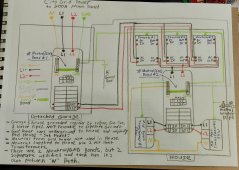CCAT Racing
New Member
- Joined
- Aug 22, 2021
- Messages
- 12
Hi, first solar forum registration. I finally purchased about $20K in solar equipment. Didn't like ANY of the offers from installers, or the type of systems, so I designed, and built my own! I am using 3 GROWATT 5KW Off Grid Inverters, 2 Solar Edge 5KW Midpoint Transformers, 2 WATTS247 PV Combiners, 2 BIGBATTERY.COM 48V 233AH "KONG" batteries, combined into 1 466AH Battery I call the "KING KONG" Battery, a DALY 200A Smart BMS, and a Renogy 500A Battery Monitor Display. With the extra BIGBATTERY.COM case, I made a 2nd 550AH Lifepo4 battery using 160 60280 55AH Lifepo4 cells, with same DALY BMS, and Renogy Display. For panels, I am using 24 ET Solar Mono 375W panels in 4 strings. System is up an running, need to install 2 more strings of panels on roof, finish 2nd battery, and finalize wiring in conduit.
I am hoping there are some GOOD residential electricians in here to help me verify my wiring is correct, and safe. Its ALL custom, so no wiring help available. I will post up a rough wiring diagram of my system once I get it finished on the PC.
I hope to be of some help here too, so any questions don't hesitate to ask!
Chris
I am hoping there are some GOOD residential electricians in here to help me verify my wiring is correct, and safe. Its ALL custom, so no wiring help available. I will post up a rough wiring diagram of my system once I get it finished on the PC.
I hope to be of some help here too, so any questions don't hesitate to ask!
Chris



